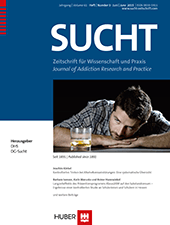Abstract
Fragestellung: Positive Effekte tiergestützter Therapie (TGT) auf Patienten sind belegt. Die vorliegende Studie geht der Frage nach, ob auch Substanzabhängige im stationären Drogenentzug von TGT profitieren und sich unmittelbare Effekte auf die emotionale Befindlichkeit und das subjektive Craving zeigen lassen. Methode: 26 Patienten (ICD-10: F11.2; F12.2, Alter:18 – 65 Jahre) wurden in der randomisiert-kontrollierten Studie im Cross-Over-Design untersucht und in Gruppe A und B aufgeteilt. Gruppe A erhielt zuerst das Interventionsangebot (Spaziergänge mit Hund) und dann das Kontrollangebot (Spaziergänge ohne Hund), bei Gruppe B wurde umgekehrt verfahren. Vor und nach jeder Intervention wurden die emotionale Befindlichkeit und das Craving der Probanden erfasst. Außerdem wurde über den Studienzeitraum hinweg die globale psychopathologische Symptombelastung der Patienten ermittelt. Ergebnisse: Es konnten signifikant stärkere prä-/post-Veränderungen unter der Interventionsbedingung mit Hund im Vergleich zu ohne Hund auf die emotionale Befindlichkeit und eine tendenziell signifikant ausgeprägtere Verringerung des Cravings nach der Intervention mit Hund aufgezeigt werden. Im Studienverlauf reduzierte sich die globale psychopathologische Symptombelastung deutlich, hier fanden sich keine hundespezifischen Effekte. Schlussfolgerung: Es ergeben sich erste Hinweise darauf, dass substanzabhängige Patienten im akutpsychiatrischen Drogenentzug kurzfristig von TGT mit einem Hund profitieren.
Aims: Research has showed beneficial effects of animal-assisted therapy (AAT) on patients. The present study investigated the immediate effects of a dog-assisted therapy on the emotional state and craving of drug-addicted patients. Methods: During drug withdrawal, 26 inpatients (ICD-10-diagnosis of F11.2 or F12.2; aged 18 – 65) participated in this randomized-controlled study based on a crossover design. Participants were randomized into two groups: Group A received the intervention first (walks accompanied by a specialist nurse with dog) and subsequently the control condition (walks accompanied by nurse without a dog), whereas the procedure was reversed for Group B. Before and after each condition, patients rated their emotional state and their current global craving. In addition, the global psychopathological symptomatology of patients was determined over the study period. Results: Analyses indicated significantly stronger pre-/post-change on the emotional state under the intervention condition (with dog) compared to the control condition (without dog). It can also be shown that there was a trend toward a stronger reduction in craving under the intervention condition. There was a significant reduction of the global psychopathological symptomatology throughout the study process, though no dog-specific effects were ascertainable. Conclusion: Our findings show that individually applied dog-assisted therapies have positive short-term effects on the well-being and craving of drug-addicted patients.
Literatur
(2009). Lust auf Abstinenz – Ein Therapiemanual bei Alkohol-, Medikamenten-und Drogenabhängigkeit. Heidelberg: Springer.
(1998). The effects of animal-assisted therapy on anxiety ratings of hospitalized psychiatric patients. Psychiatric Services, 49, 797 – 801.
(1986). Use of animals in the rehabilitation of psychiatric inpatients. Psychological Reports, 58, 63 – 66.
(1994). Measuring emotion: the self-assessment manikin and the semantic differential. Journal of behavior therapy and experimental psychiatry, 25(1), 49 – 59.
(2009). Statistik für Psychologen und Sozialwissenschaftler. München: Pearson Studium.
(2003). Tierbesuch und Tierhaltung als Therapiehilfe im Krankenhaus. In C. Otterstedt & E. OlbrichEds., Menschen brauchen Tiere (pp. 199 – 213). Stuttgart: Kosmos Verlags GmbH.
(2007). G* Power 3: A flexible statistical power analysis program for the social, behavioral, and biomedical sciences. Behavior research methods, 39, 175 – 191.
(2003). Das Ausdrucksverhalten und die Kommunikation von Hunden in ihrer Bedeutung im therapeutischen Kontext. In C. Otterstedt & E. OlbrichEds., Menschen brauchen Tiere (pp. 348 – 359). Stuttgart: Kosmos Verlags GmbH.
(2000). BSI: brief sympton inventory von LR Derogatis; Kurzform der SCL-90-R); deutsche Version. Göttingen: Beltz Test.
(2009). Psychologische Interventionen in Gefängnissen am Beispiel der multiprofessionellen tiergestützten Intervention (MTI) in einer Anstalt für entwöhnungsbedürftige Rechtsbrecher. Diplomarbeit, Universität Wien: Wien.
(2011). Short-term interaction between dogs and their owners: Effects on oxytocin, cortisol, insulin and heart rate—An exploratory study. Anthrozoös, 24, 301 – 315.
(1999). Health benefits and health cost savings due to pets: preliminary estimates from an Australian national survey. Social Indicators Research, 47, 233 – 243.
(2009). Dog-assisted intervention significantly reduces anxiety in hospitalized patients with major depression. European Journal of Integrative Medicine, 1, 145 – 148.
(2010). Tiergestütztes Kompetenztraining (MTI) im stationären Drogenentzug. Diplomarbeit, Universität Wien, Wien.
(1999). Drogenentzugstherapien. Der Internist, 40, 624 – 627.
(2000). Animal-assisted therapy in psychiatric rehabilitation. Anthrozoös, 13, 43 – 47.
(2011). Animal-assisted interventions in internal and rehabilitation medicine: a review of the recent literature. Panminerva medica, 53, 129 – 136.
(2009). [Development and validation of an overall instrument to measure craving across multiple substances: the Mannheimer Craving Scale (MaCS)]. Psychiatrische Praxis, 36, 72 – 78.
(2007). Animal-assisted therapy: A meta-analysis. Anthrozoös, 20, 225 – 238.
(2001). Tiere als therapeutische Begleiter. Gesundheit und Lebensfreude durch Tiere – eine praktische Anleitung. Stuttgart: Kosmos.
(2000). The measurement of drug craving. Addiction, 95, 189 – 210.
(2007). Do animal-assisted activities effectively treat depression? A meta-analysis. Anthrozoös, 20, 167 – 180.
(2009). Changes in emotional competences of drug offenders during dog-assisted group training (MTI). Journal of Veterinary Behavior: Clinical Applications and Research, 4, 99 – 100.
(1998). Oxytocin may mediate the benefits of positive social interaction and emotions. Psychoneuroendocrinology, 23, 819 – 835.
(2010). Handbuch der tiergestützten Intervention: Grundlagen, Konzepte, Praxisfelder: Quelle-&-Meyer-Verlag.
(2012). Vom richtigen Umgang mit dem Crossover-Design in klinischen Studien. Deutsches Ärzteblatt, 109, 276 – 281.
(2009). Animal-assisted therapy in the treatment of substance dependence. Anthrozoös, 22, 137 – 148.
(1997). How to assess craving for alcohol. European Addiction Research, 3, 110 – 115.



